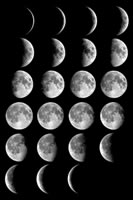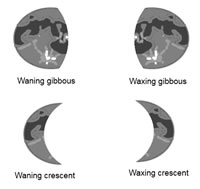Key difference: Waxing and waning are two terms that are often related to the phases of the moon. The process of the lunar phases shifting between the new moon and the full moon falls under the terms waning and waxing. According to Dictionary.com, a waning moon is “the moon at any time after full moon and before new moon (so called because its illuminated area is decreasing).” Whereas, a waxing moon is “the moon at any time after new moon and before full moon, so called because its illuminated area is increasing.”

Waxing and waning are two terms that are often related to the phases of the moon. A lunar phase is the “appearance of the illuminated (sunlit) portion of the Moon as seen by an observer, usually on Earth.” This occurs as the Moon orbits the Earth. The reason for the various appearances is the changing relative positions of the Earth, Moon, and Sun. The moon appears as a full moon when the Sun and Moon are on opposite sides of the Earth. It appears as a new moon when the Sun and Moon are on the same side of Earth. The phases of full moon and new moon occur when the Earth, Moon, and Sun lie approximately in a straight line.
The moon does not have light of its own; it instead reflects the light off the sun. The half of the lunar surface facing the Sun is always sunlit. However, at any given time from Earth, parts of the moon can be visible, depending on where the moon is at its orbit around the Earth. These can vary from 0% (new moon) to 100% (full moon). A new moon occurs when the Moon is between the Earth and the Sun. A full moon occurs when the Moon is on the far side of the Earth from the Sun.

The process of the lunar phases shifting between the new moon and the full moon falls under the terms waning and waxing. According to Dictionary.com, a waning moon is “the moon at any time after full moon and before new moon (so called because its illuminated area is decreasing).” Whereas, a waxing moon is “the moon at any time after new moon and before full moon, so called because its illuminated area is increasing.”
The moon goes through a cycle of its phases every month. It takes approximately 29.5 days to complete this cycle. This period of 29.53 days is called a lunar month. The concept of the calendar month is derived from the lunar month. In fact, the word ‘month’ is derived form ‘moon.’ The month starts with the new moon up to the full moon, which halfway through the lunar month, i.e. the 15th day. Then it goes back to the new moon, at which time, the cycle begins anew.
Phases of the moon through the lunar month: New Moon – Waxing Crescent Moon – First Quarter Moon – Waxing Gibbous Moon – Full Moon – Waning Gibbous Moon – Third (Last) Quarter Moon – Waning Crescent Moon – Dark Moon.
Image Source: aa.usno.navy.mil, blog.barmonger.org







































